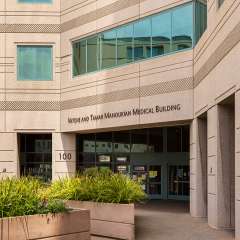Reza Jahan, MD
- Interventional Neuroradiology
About
Background:
Dr. Reza Jahan is a professor in the division of interventional neuroradiology, department of radiology and neurosurgery and a member of the UCLA Stroke Center. His practice focuses on endovascular treatment of cerebrovascular disorders including brain aneurysms, brain vascular malformations and ischemic stroke. He has been in practice since he joined the faculty at UCLA on July 1, 1999. As a faculty member in his division, Dr. Jahan has trained over 30 physicians in his area of expertise, many of whom have moved on to establish successful academic and clinical practices at major university hospitals in this country. He is director of the neurointerventional radiology elective course for medical students, director of academic affairs in his division and director of the Translational Research Imaging Center in the department of radiology. He obtained his baccalaureate degree in biochemistry from the UCLA Department of Chemistry and his medical degree from the David Geffen School of Medicine at UCLA. He completed his internship in medicine and his radiology residency at the same institution. He then spent three years obtaining his subspecialty training in interventional neuroradiology at the UCLA Division of Interventional Neuroradiology. Following completion of his training in July of 1999, he has been a full time faculty member at the Ronald Reagan UCLA Medical Center.
Clinical:
Dr. Jahan has been an active member of the Division of Interventional Neuroradiology since July of 1999 and has treated over 1500 patients with cerebrovascular disorder including endovascular embolization of aneurysms, brain and spinal arteriovenous malformations, brain and spinal dural arteriovenous fistulas. As is evident from his research activity, his primary interest has been in ischemic stroke intervention and he has a National / International reputation as an expert in this area with leading roles in clinical trials. He has also been involved in training and proctoring neurointerventional radiologists, interventional neurosurgeons and neurologists in new technology. He was active in training physicians with the new embolic agent Onyx when it was first FDA approved in 2005 and is currently active in training physicians in the use of the Solitaire Flow Restoration Device. Dr. Jahan's clinical interests include Interventional Spine Service.
Research:
Dr. Jahan has been active in the evaluation and development of novel endovascular devices and drugs for emergent treatment of stroke patients. Recently, he served as the national co-principal investigator of the SWIFT study evaluating a novel endovascular device, the Solitaire device, for removal of blood clots from brain arteries in patients experiencing an ischemic stroke. He also carried out the pre-clinical studies that lead to the national clinical trial for this device. He then was the international neurointerventional advisor for the follow up study the SWIFT Prime study, that was completed in February of 2015 and published in the New England Journal of Medicine with Dr. Jahan as senior author on the manuscript.
Dr. Jahan is a member of the UCLA Stroke Center, one of only seven institutions in the nation that has been successful in obtaining a grant from the National Institutes of Health to carry out translational research in the field of stroke. Dr. Jahan was the co-principal investigator of one of the projects under this grant entitled the MR Rescue Trial. The trial succeeded in recruiting 120 patients in 30 international sites and completed data collection in March of 2012. The study was published in the New England Journal of Medicine.
Dr. Jahan has also been active in development of novel drugs for ischemic stroke and was successful in developing a recanalization ischemic stroke model in pre-clinical studies to test the safety and efficacy of a new clot busting medication called delta-Plasmin. The drug is potentially capable of rapidly dissolving clots in patients experiencing ischemic stroke and may serve as a great adjunct along with devices to help patients afflicted with this devastating disease.
Languages
Education
Medical Board Certification
Fellowship
Residency
Internship
Degree
Recognitions
- Super doctors, Southern California, 2025
- Super Doctors® Southern California, 2023 - 2025
- Top Doctors, Los Angeles Magazine, 2021
- Top Doctors, Los Angeles Magazine, 2018
Locations

Westwood Imaging Center & Interventional Radiology Clinic
Hospital Affiliations
Medical Services
Areas of Focus
Videos
Research
Interests
- Acute Stroke Intervention
- Radiosurgical Treatment of Brain Arteriovenous Malformations
Publications
Insurance
- Aetna
- Anthem Blue Cross
- Blue Shield of California
- Centivo
- Cigna
- First Health
- Health Net of California
- Interplan (part of HealthSmart)
- Medicare Advantage
- MultiPlan
- UFCM Health System
- Prime Health Services
- Private Healthcare Systems (PHCS)
- TRICARE
- UnitedHealthcare
The list of health care plans above may not be comprehensive and could change.
Please contact your benefits coordinator or health insurance company directly to verify coverage.
Visit our health insurance information page for more details.
Recognitions
- Super Doctors® Southern California, 2023 - 2025
- Top Doctors, Los Angeles Magazine, 2021
- Top Doctors, Los Angeles Magazine, 2018

